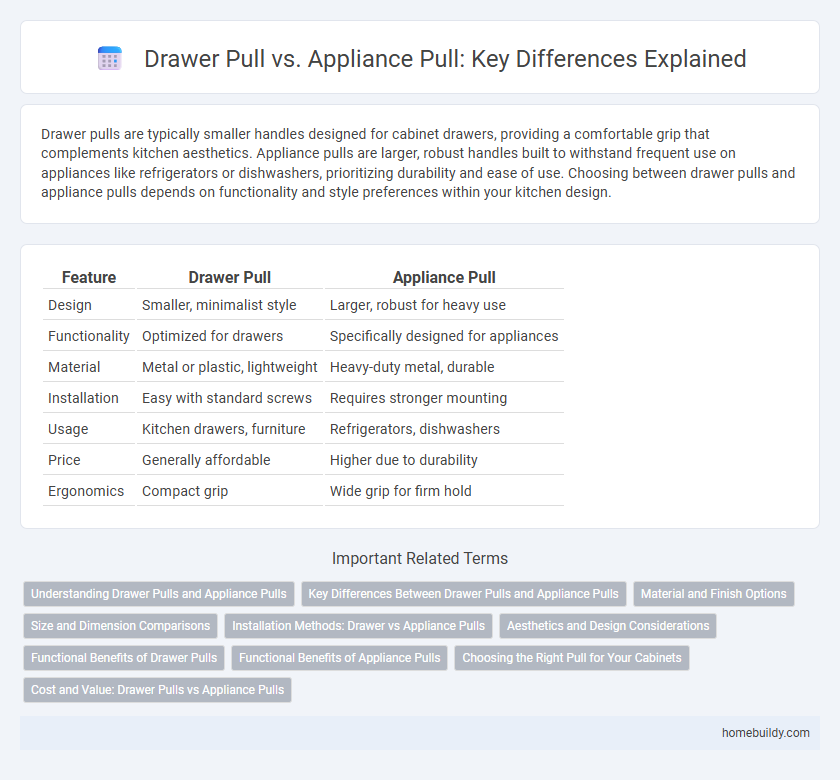Drawer pulls are typically smaller handles designed for cabinet drawers, providing a comfortable grip that complements kitchen aesthetics. Appliance pulls are larger, robust handles built to withstand frequent use on appliances like refrigerators or dishwashers, prioritizing durability and ease of use. Choosing between drawer pulls and appliance pulls depends on functionality and style preferences within your kitchen design.
Table of Comparison
| Feature | Drawer Pull | Appliance Pull |
|---|---|---|
| Design | Smaller, minimalist style | Larger, robust for heavy use |
| Functionality | Optimized for drawers | Specifically designed for appliances |
| Material | Metal or plastic, lightweight | Heavy-duty metal, durable |
| Installation | Easy with standard screws | Requires stronger mounting |
| Usage | Kitchen drawers, furniture | Refrigerators, dishwashers |
| Price | Generally affordable | Higher due to durability |
| Ergonomics | Compact grip | Wide grip for firm hold |
Understanding Drawer Pulls and Appliance Pulls
Drawer pulls and appliance pulls differ primarily in size, design, and function, with drawer pulls being smaller and designed for frequent hand use on cabinets and furniture. Appliance pulls are larger, sturdier, and intended for heavy-duty applications such as refrigerators, ovens, or dishwashers, providing a comfortable grip for larger appliance doors. Selecting the right pull depends on matching the hardware to the door or drawer's use and size for ergonomic functionality and aesthetic coherence.
Key Differences Between Drawer Pulls and Appliance Pulls
Drawer pulls are typically smaller and designed for ease of grip on cabinet drawers, while appliance pulls are larger, sturdier, and built to handle the frequent use and heavier weight of appliances like refrigerators and ovens. Drawer pulls often feature decorative designs to enhance cabinetry aesthetics, whereas appliance pulls prioritize durability and functionality with robust materials such as stainless steel. The key differences lie in size, strength, mounting style, and intended usage, with appliance pulls needing to withstand higher stress and frequent handling compared to drawer pulls.
Material and Finish Options
Drawer pulls and appliance pulls differ significantly in material and finish options, catering to various design needs. Drawer pulls commonly feature materials like brass, stainless steel, zinc alloy, and sometimes wood, offering finishes such as brushed nickel, matte black, oil-rubbed bronze, and polished chrome for diverse interior styles. Appliance pulls are typically constructed from durable stainless steel or aluminum to withstand higher usage and come in finishes like satin stainless, black stainless, and chrome, prioritizing both aesthetic appeal and resistance to wear and fingerprints.
Size and Dimension Comparisons
Drawer pulls typically measure between 3 to 5 inches in length, designed for easy grip and ergonomic use on smaller drawer fronts. Appliance pulls are larger, often ranging from 7 to 12 inches, to accommodate the bigger surface area of refrigerators, ovens, and dishwashers, providing a balanced look and functional leverage. The size difference directly impacts installation spacing and style coordination, with appliance pulls requiring more robust anchoring systems due to their length and heavier use.
Installation Methods: Drawer vs Appliance Pulls
Drawer pulls typically require screws that are installed from the inside of the drawer front, ensuring a secure and concealed attachment, whereas appliance pulls often use a bolt-through mounting system designed for thicker doors or panels. Installation of drawer pulls involves aligning pre-drilled holes and tightening screws within confined interior spaces, while appliance pulls may require access to the backside of doors or panels for proper bolt fastening. The difference in installation methods reflects the distinct structural designs and functional requirements of drawers versus appliances.
Aesthetics and Design Considerations
Drawer pulls typically offer a more delicate and refined aesthetic, enhancing traditional or classic cabinetry styles with their varied shapes and finishes. Appliance pulls tend to be larger and more robust, designed to complement modern kitchen appliances and provide a cohesive, streamlined look. Choosing between drawer pulls and appliance pulls depends on the overall kitchen design, balancing function with the desired visual impact.
Functional Benefits of Drawer Pulls
Drawer pulls offer superior ergonomic design that enhances grip comfort and ease of use, making them ideal for frequent access in kitchens and furniture. Their variety of sizes and mounting options allow seamless integration with different drawer types, providing both functionality and style. Unlike appliance pulls, drawer pulls are optimized for durability and smooth operation in daily handling.
Functional Benefits of Appliance Pulls
Appliance pulls offer enhanced grip and durability compared to standard drawer pulls, making them ideal for heavy-duty use. Their larger size and ergonomic design facilitate easier opening of larger drawers or appliance doors. Constructed from robust materials like stainless steel, appliance pulls resist wear and provide long-lasting functionality in high-traffic kitchen environments.
Choosing the Right Pull for Your Cabinets
Selecting the right pull for your cabinets depends on both functionality and style, with drawer pulls designed for smooth grip and frequent use, while appliance pulls offer a robust, industrial look suitable for heavy-duty applications. Drawer pulls typically feature ergonomic shapes that enhance ease of opening, making them ideal for kitchen and bathroom cabinetry. Appliance pulls, often larger and sturdier, are best suited for integrated appliances or cabinets that require a more substantial handle to match the overall design.
Cost and Value: Drawer Pulls vs Appliance Pulls
Drawer pulls generally cost less than appliance pulls, making them a budget-friendly option for kitchen hardware upgrades. Appliance pulls, designed for heavier use and larger drawers or appliances, often come with higher durability and thus a higher price point, offering long-term value. Choosing between drawer pulls and appliance pulls depends on balancing upfront cost with expected wear and tear, where appliance pulls may justify their cost through increased longevity and performance.
Drawer pull vs Appliance pull Infographic

 homebuildy.com
homebuildy.com